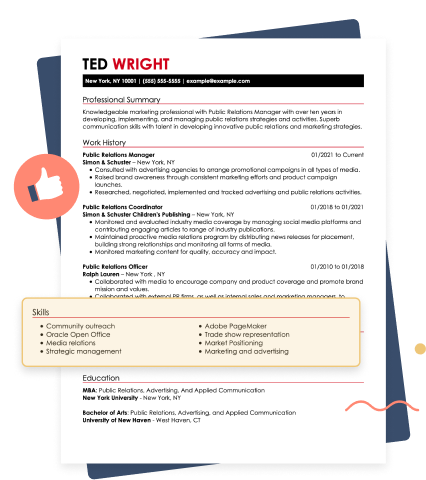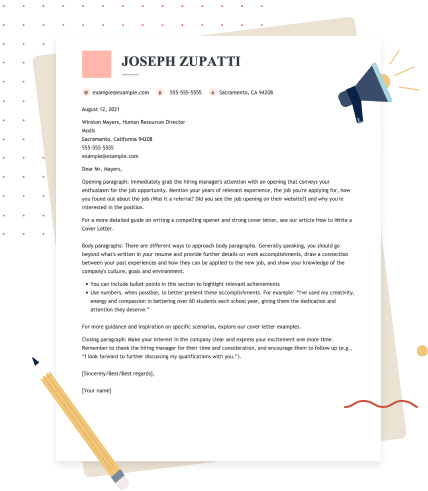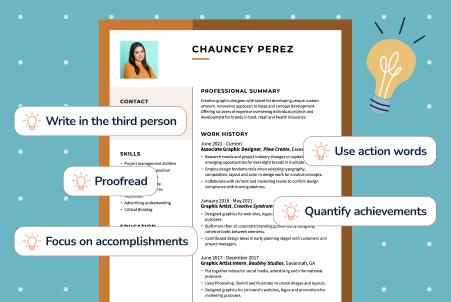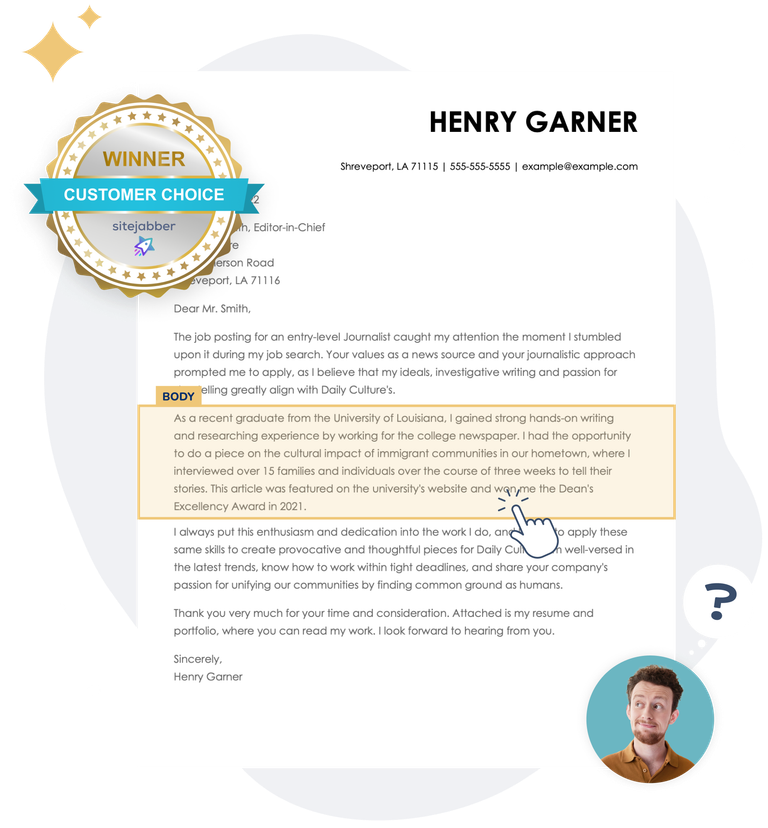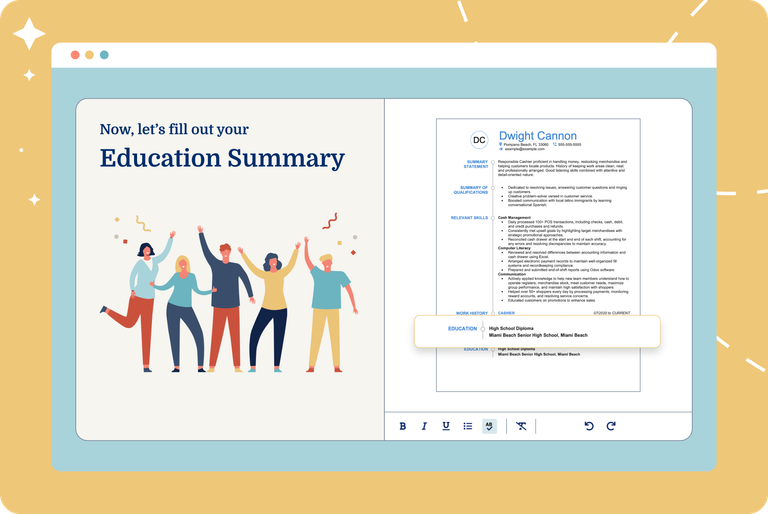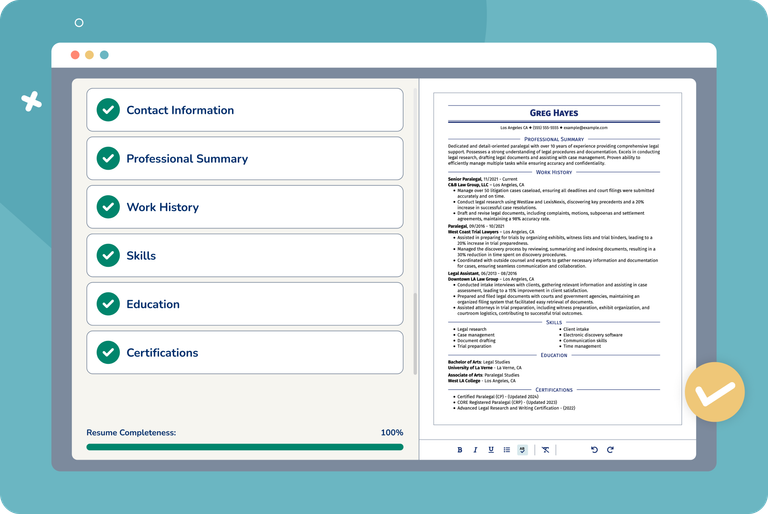Our customers have been hired at: *Foot Note
Navigating the job market as a person with a disability can feel overwhelming, but it can also be an empowering process when you know your rights, understand your marketable strengths, and have access to the right tools and support.
Whether you’re just beginning your job search or returning to the workforce, this guide is here to help. Discover strategies for building a standout application, finding inclusive employers, and navigating the hiring process with confidence and clarity.
Discovering Your Strengths and Interests
A successful job search starts with understanding what professional skills you bring to the table and what kind of work will be meaningful and sustainable for you. Learn how to explore your skills, reflect on your interests, and identify potential career paths that align with your goals and needs.
Exploring your professional skills
Before you begin applying for jobs, it’s important to take stock of your skills, especially the ones that can help you succeed across different roles or industries.
Whether you’ve worked in formal jobs, volunteered, completed training, or managed responsibilities at home, you likely already have valuable skills to highlight.
Understanding different types of skills, such as transferable, technical, and soft skills, can help you communicate your strengths confidently in your resume and cover letter and during job interviews.
Soft skills
Soft skills are interpersonal traits and work habits that affect how you interact with others and manage responsibilities.
For instance, if you stayed focused and adaptable during a stressful situation, or supported a teammate or family member through a difficult period, those are strong demonstrations of soft skills.
Sharing how you’ve navigated challenges not only demonstrates resilience and adaptability but also shows your commitment to contributing meaningfully to the team. Always remember, your journey and story are your greatest assets.- Dr. Jasmine Escalera, Career Professional
Transferable skills
Transferable skills are skills you can carry from one job or situation to another, regardless of the industry. They often come from life experience, volunteering, education, or previous work.
For example, if you've helped coordinate appointments or managed a household schedule, you've used planning and organizational skills that employers value.
Technical skills
Technical skills are job-specific abilities you’ve gained through education, training, or direct experience. They often relate to using specific tools, systems, or processes.
If you’ve completed vocational training or used a screen reader or voice-to-text software regularly, that’s technical expertise worth noting.
Aligning your interests with potential career paths
When your daily work aligns with your interests, it often leads to more satisfaction, confidence, and long-term success. Start by asking yourself:
- What types of tasks do I enjoy or feel most comfortable doing?
- Do I prefer working with people, data, hands-on tools, or creative ideas?
- What topics or causes am I passionate about?
- Do I enjoy routine or variety? Structure or flexibility?
Your answers can point you toward jobs that match both your interests and strengths, whether you’re exploring work for the first time or making a career change.
For example, if you enjoy organizing and planning, you might thrive in administrative support roles. If you love working with numbers, consider roles in data entry, accounting, and information technology.
Try career exploration tools like MyNextMove.org, O*NET Interest Profiler, and CareerOneStop Skills Matcher to help identify career paths that align with your personality, preferences, and values.
Addressing potential skill gaps and planning for development
As you explore different career paths, you may notice some skills or certifications that you don’t yet have, and that’s okay. Identifying skill gaps is a positive step toward finding a job that fits your goals.
Whether you’re entering the workforce for the first time, returning after time away, or changing careers, building new skills can boost your confidence and help you stand out to employers.
As you plan, focus on skills that align with your interests and target roles—and remember, you don’t have to master everything at once. Your local vocational rehabilitation (VR) agency may offer personalized skill-building programs. Here are a few additional resources to help you get started:
- Coursera.org: Offers free and low-cost courses from top universities and companies. Many courses include accessibility features and allow you to learn at your own pace.
- GCFGlobal.org: Provides free tutorials in basic computer use, workplace readiness, and life skills—ideal for beginners or those returning to the workforce.
- Per Scholas: Delivers free, high-quality tech training with a focus on diversity and inclusion. Programs include career coaching and job placement support.
- LinkedIn Learning: Offers short, self-paced courses in business, technology, and creative fields. You can explore content by skill level and earn completion certificates.
- General Assembly: Provides immersive training in tech, data, design, and digital marketing, with support available to help learners succeed in their programs.
Laying the groundwork for your job search
Now that you’ve explored your strengths, interests, and skill development goals, you’re ready to take the next step in launching your job search. The checklist below is designed to help you get started:
Creating a Resume as a Person With a Disability
Your resume is your first chance to make a strong impression on recruiters and hiring managers. It should showcase your experience while also pointing toward your future potential. Explore practical tips for highlighting your strengths, skills, and qualifications to stand out.
Highlight your relevant skills
In today’s job market, many companies are shifting toward skills-based hiring, placing more emphasis on what you can do rather than where you’ve worked or your formal education. This means highlighting your skills effectively is more important than ever.
Use the job posting as your roadmap. Identify key skills or qualifications that are mentioned and ensure your resume reflects them clearly, ideally in the top half of the page.
These might include hard skills like typing speed, familiarity with specific software, or data entry accuracy. Just as important are your soft skills—qualities like reliability, attention to detail, and clear communication, which help you work effectively with others and navigate day-to-day responsibilities.
You can use our AI Resume Skills Generator to create a tailored list of skills for your target role:
AI Resume Skills Generator
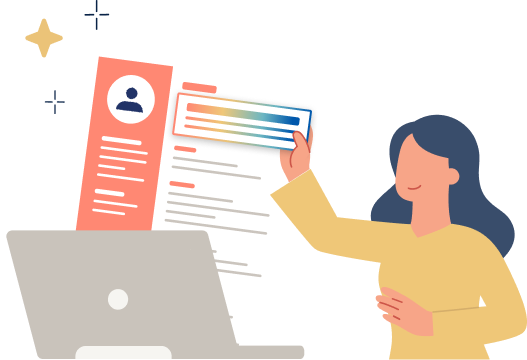
Address employment gaps strategically
If your work history includes breaks for medical treatment, caregiving, education, or other life circumstances, know that you’re not alone, and these gaps don’t diminish your potential.
With thoughtful presentation, you can frame employment gaps on your resume in a way that supports your overall story and helps employers focus on your strengths.
You don’t always need to explain a gap on your resume, especially if it was short or occurred several years ago. In many cases, employers are more focused on your recent experience and skills.
However, if the gap is longer than a few months and feels significant, you can choose to briefly acknowledge it in your work history section. For example, you might write: "Medical leave of absence, [dates], during which I focused on recovery and skill development."
Note any relevant activities you worked on during this time, such as volunteer work, freelance projects, coursework, certifications, or personal development. Demonstrating continuous growth reassures employers that you stayed engaged and proactive.
Using a combination resume format can help emphasize your abilities, drawing attention to your achievements rather than focusing solely on chronological work history.
When it comes to any career gaps, be honest, but strategic. You don’t need to explain every gap on your resume. Instead, emphasize how your unique journey has equipped you with the specific skills and experiences outlined in the job description, demonstrating your readiness and fit for the role.- Dr. Jasmine Escalera, Career Professional
Use strong action verbs and measurable achievements
When writing your resume, start bullet points with strong action verbs that communicate what you did. Words like managed, improved, created, streamlined, and implemented help paint a more vivid picture of your role and achievements.
Whenever possible, quantify your accomplishments to help employers understand the value you delivered. Numbers, percentages, or clear outcomes make your contributions more concrete.
If you’re reentering the workforce, consider including measurable achievements from volunteer roles, freelance projects, coursework, or skill-building activities during a career pause. What matters most is showing how your actions led to positive results. Here are a few examples:
- Completed a 10-week online certification in Microsoft Excel, now using advanced functions to streamline data entry tasks.
- Organized a community fundraiser that raised $3,000, coordinating communications, outreach, and logistics.
- Tutored three students in basic computer skills, improving their comfort with using email, web browsers, and productivity software.
To simplify the writing process, you can use the MyPerfectResume Resume Builder, which offers prompts, professional templates, and helpful content suggestions for every section of your resume.
Mention assistive technology proficiency (if relevant)
If you use assistive technology to succeed at work, it can be a strength worth showcasing. For example, if you're applying for a job that values proficiency with digital platforms or accessibility awareness, mentioning your experience with assistive technology can demonstrate valuable skills.
Tools like screen readers (JAWS, NVDA), speech-to-text software (Dragon NaturallySpeaking), screen magnifiers, or alternative input devices demonstrate adaptability, computer skills, and the ability to navigate digital environments effectively.
You can include assistive technology experience in your skills section or as part of a bullet point under a specific role or project. Be sure to focus on how the tool helped you accomplish tasks, solve problems, or contribute to team goals. Here are a few examples:
- Used Dragon NaturallySpeaking to transcribe client notes with 98% accuracy, improving documentation speed and quality.
- Navigated workplace software efficiently with the JAWS screen reader to manage scheduling, email, and task tracking.
- Created accessible documents using formatting best practices to support team collaboration and screen reader compatibility.
Keep your format clean and easy to read
A well-formatted resume makes it easier for hiring managers to identify your qualifications. Use a professional layout with consistent spacing, clear headings, and standard fonts like Arial or Calibri.
Avoid dense paragraphs or cluttered visuals. Instead, organize your experience into bullet points and use bold or italics sparingly to draw attention to key details.
Many employers use applicant tracking systems (ATS) to scan, organize, and filter resumes before they reach the hiring manager. To create an ATS-friendly resume, avoid tables, graphics, or unusual fonts that could interfere with how automated systems scan and interpret your content.
Using a resume template can help you stay organized and maintain a clean design. Choose one that prioritizes readability and structure, especially if you use assistive technology or want to ensure your resume is compatible with screen readers.
Resume Examples for People With Disabilities
Explore resume examples that demonstrate how to effectively showcase your strengths, address employment gaps, and incorporate relevant details like assistive technology proficiency.
First-time job seeker
To write an effective resume without experience, this first-time job seeker highlights transferable skills, relevant volunteer experience, and education.
Additionally, they showcase proficiency with assistive technology in the professional skills section to demonstrate adaptability and technical capability.
Job seeker with a career gap
This resume is designed for a job seeker returning to the workforce after an employment gap due to a medical leave of absence.
It balances a strong skills section with a chronological work history, allowing the candidate to highlight relevant abilities while briefly addressing the leave in the work history section.
Job seeker applying for a remote position
This resume example is for a job seeker applying to a remote customer service position. It emphasizes a consistent work history, relevant customer support experience, and remote work skills, such as communication, time management, and proficiency with virtual collaboration tools.
Crafting a Powerful Cover Letter
While your resume shows what you’ve done, your cover letter is your chance to show enthusiasm, explain your interest in a role, and make a personal connection with the employer.
Browse tips on how to write a cover letter that highlights your strengths, aligns with the job posting, and leaves a memorable impression.
Tailor your letter to the role you are applying for
Customize your cover letter for each job you apply to by aligning your skills and experiences with the specific requirements of the role. Start by reviewing the job posting carefully. Identify keywords, essential responsibilities, and qualifications the employer is seeking.
Reflect those themes in your letter by sharing examples that show how your background makes you a great fit. Mention the company by name and speak to why their mission or values resonate with you.
Personalization demonstrates genuine interest and helps your letter stand out, for example:
You can use our Cover Letter Generator to create a personalized, professional letter quickly and easily—no writing experience required.
Showcase your enthusiasm and qualifications
Your cover letter is more than just a summary of your resume. It’s a chance to show employers why you're genuinely excited about the opportunity and how you’re uniquely qualified. To do this, connect your values or perspective to the employer’s goals.
This is especially effective if you bring a lived experience that enhances your qualifications, such as disability-informed insight, adaptability, or creative problem-solving. These strengths can help you stand out and demonstrate how you’ll contribute meaningfully to the role. For example:
Our professional cover letter templates can help you get started, providing structure and phrasing guidance while still allowing you to customize your message for the specific role and company.
Disclosing a disability (if you choose to)
Whether or not to disclose a disability in your cover letter is a personal choice, and it's important to approach it with care. Keep in mind that you're never required to share this information in your cover letter or job application.
If you choose to disclose, your letter can briefly mention your eligibility for special hiring programs (such as Schedule A) or your openness to discuss accommodations, while keeping the focus on your skills and qualifications. Here is an example:
If you choose to disclose your disability, remember that this is your story to share, and you have the right to do so on your own terms. Focus on your abilities and the strategies you use to excel in your work. By framing your disclosure around your strengths and the unique perspective you bring, you can help employers see the tremendous value you offer because you truly are valuable.- Dr. Jasmine Escalera, Career Professional
Cover Letter Examples for People With Disabilities
Browse cover letter examples tailored for different situations, including disclosure of disability, career changes, and returning to the workforce after some time away.
Job seeker returning to the workforce
This cover letter is for a job seeker returning to the workforce after a disability-related leave. It focuses on transferable skills, recent skill-building, and a confident, forward-looking tone that emphasizes readiness to contribute and grow in a new role.
Career changer
This cover letter example is for a career changer transitioning from the education field into a customer service role. It highlights transferable skills such as communication, problem-solving, and empathy, while demonstrating enthusiasm for learning and adapting to a new industry.
Job seeker applying for a federal position
This cover letter sample is for a job seeker applying to a federal position and includes a mention of Schedule A eligibility. It communicates the candidate’s qualifications, expresses interest in the role, and requests consideration under the Schedule A hiring authority for individuals with disabilities.
How to Find the Right Job for You
Discover helpful tips below to identify the work environment that best fits your needs and learn where to find inclusive opportunities aligned with your goals.
Remote and flexible work
Remote and work-from-anywhere jobs offer greater control over your schedule and work environment, which can be especially beneficial for individuals with disabilities.
Many employers now offer fully remote roles or hybrid arrangements that let you tailor your work hours to fit your personal needs. Flexible work can include varied start and end times, part-time hours, or project-based assignments that provide more autonomy.
These options often reduce challenges related to commuting, accessibility, and energy management, allowing you to focus on your strengths and productivity.
When reviewing job postings, look for keywords like remote-first, asynchronous team, flexible hours, or location-independent. Consider companies known for inclusive practices and those that provide accommodations for people with disabilities.
Choosing a career that fits your strengths
Finding a career that aligns with your unique strengths, skills, and interests is key to long-term job satisfaction and success.
Reflect on what tasks energize you, what environments you thrive in, and which skills you enjoy using most. Assess your abilities, including those you’ve developed through work, education, or life experiences, and consider how they translate to different industries or roles.
For example, if you prefer structured, behind-the-scenes work, data entry or bookkeeping might be a good fit. If you enjoy interacting with people and solving problems, customer service or peer mentoring roles could be a better match.
Adaptable jobs for people with disabilities
Many jobs today can be tailored to suit different abilities, work styles, and accommodation needs, making them more accessible and sustainable for people with disabilities.
When evaluating job options, look for employers open to accommodations and roles that emphasize results over rigid processes.
These adaptable roles often focus on skills and allow for flexibility in how, when, and where the work is done. Some examples of adaptable jobs for disabled people include:
- Customer service representative: Especially in remote settings, this role allows for flexibility in schedule and environment.
- Data entry clerk: A role that focuses on accuracy and speed, with minimal physical demands and the option to work independently and remotely.
- Virtual assistant or administrative support: Involves scheduling, organization, and communication skills, all of which can be customized to individual strengths.
- Graphic designer or digital content creator: Creative roles that can be performed with assistive tech and often allow flexible hours and pacing.
- Software developer: This role emphasizes technical problem-solving and can often be performed from home, with tools tailored to support various access needs.
- Technical support specialist: Focuses on resolving tech-related issues via phone, chat, or email, skills that can often be applied remotely with communication tools.
- Social media manager: Involves creating, scheduling, and analyzing content across platforms, often allowing for creative expression and asynchronous work schedules.
- Transcriptionist: Requires strong listening and typing skills but is low in physical demands and often offers the flexibility to work independently and remotely.
- Online tutor or e-learning facilitator: Provides instructional support in subjects like math, language, or coding. This work can often be tailored to your strengths.
- Content writer or editor: Involves crafting written material across various industries. Many roles are deadline-driven rather than time-based, allowing for self-paced work.
Inclusive employers hiring for remote roles
The rise of flexible work has opened doors to remote jobs for people with disabilities. Many companies now offer remote or hybrid positions, along with workplace accommodations.
To find inclusive employers, look for organizations that participate in disability hiring initiatives like the Disability Equality Index, have strong employee resource groups (ERGs) for people with disabilities, are transparent about their accommodation policies, and offer accessible job application options.
Here are some employers known for their inclusive hiring practices and remote opportunities:
- Microsoft: Offers remote tech, support, and administrative roles, along with strong accessibility programs and a Disability ERG.
- CVS Health: Frequently hires for remote customer service and healthcare support roles; also partners with disability inclusion initiatives.
- Salesforce: Provides flexible remote positions in tech, marketing, and operations, and is recognized for its inclusive workplace culture.
- Amazon: Offers virtual customer service roles and participates in disability hiring programs through its AmazonPWD network.
- UnitedHealth Group: Hires for remote healthcare, data, and support roles, and emphasizes workplace accessibility and flexibility.
- Google: Offers remote and hybrid roles in engineering, design, and operations, with a strong focus on accessibility and disability inclusion through its Disability Alliance ERG.
- Dell Technologies: Known for its remote-first culture, with roles in IT, sales, and customer service, and a commitment to inclusive hiring practices.
- Elevance Health: Frequently posts remote healthcare and customer support roles, with a focus on inclusive employment and accessible systems.
- American Express: Offers remote roles in customer care, finance, and tech, and has been recognized for its disability inclusion and workplace flexibility.
- SAP: Provides remote roles in software, sales, and business operations, and runs the Autism at Work and broader disability inclusion programs worldwide.
Where to search for jobs
Several online platforms and programs offer support to job seekers with disabilities, especially those seeking remote or flexible opportunities. Explore where to begin your search below.
Online platforms for remote or tailored job opportunities
- FlexJobs: A leading job board for remote, hybrid, and flexible roles across a wide range of industries. Listings are updated daily and hand-screened for legitimacy.
- Remote.co: Offers a wide range of remote job listings in fields like customer service, data entry, writing, and tech.
- We Work Remotely: A popular remote job board with regularly updated roles in tech, customer support, design, and more.
- WorkingNomads: Curates remote job listings from across the web, especially in tech, marketing, and customer support, with a simple interface and daily updates.
- USAJOBS.gov: The official job site for U.S. federal government positions. Use the "Individuals with disabilities" hiring path filter for tailored opportunities.
Specialized services supporting job seekers with disabilities
- Workforce Recruitment Program: A recruitment and referral program that connects employers with college students and recent graduates with disabilities seeking jobs.
- CareerCircle: An online career development platform offering coaching, webinars, and job leads specifically for people with disabilities.
- DiversityJobs: A job board dedicated to diversity hiring, including disability-focused recruitment, connecting inclusive employers to qualified candidates.
- abilityJOBS: An online job board focusing exclusively on employment opportunities for people with disabilities, featuring inclusive employers and disability-friendly roles.
- Inclusively: A platform that matches job seekers with disabilities to inclusive companies, allowing them to indicate preferred workplace accommodations.
Don’t forget about vocational rehabilitation services. Every state has a VR agency that provides job placement support, training, and assistive technology resources to eligible individuals with disabilities.
Navigating the Hiring Process
The hiring process can feel daunting when you’re managing accessibility needs or wondering whether to disclose a disability. But with preparation, self-awareness, and a clear understanding of your rights, you can approach each step with confidence and clarity.
Preparing for the interview
Interviews come in many formats, each with its own expectations and best practices. Explore tips on how to prepare for a job interview to maximize your chances of landing the role.
Interview formats
Knowing what to expect from each interview format can help you prepare more effectively and reduce anxiety. Here are a few common interview formats to prepare for:
Answering questions strategically
During an interview, your goal is to demonstrate not only what you've done but also how you think, solve problems, and add value to a team.
One effective approach is to use the STAR method, which involves describing the Situation, Task, Action, and Result when answering experience-based questions. This helps structure your responses into clear, compelling stories that highlight your strengths.
For instance, rather than saying you "handled customer service calls," you could say, "managed an average of 50 customer service calls daily, implementing a new triage system that reduced response times by 20% and contributed to a 15% increase in customer satisfaction scores over six months."
If your work history includes an employment gap, frame it in a positive, forward-looking way. Keep it brief and emphasize your readiness to contribute.
A simple statement like, "After taking time for medical treatment, I’m excited to return to the workforce and bring renewed focus to a role like this," can help acknowledge the gap while keeping the focus on your strengths.
Don’t be afraid to pause, gather your thoughts, or ask for clarification if you’re unsure about a question. Staying calm, thoughtful, and authentic under pressure shows confidence and professionalism.
Ask insightful questions
Asking thoughtful questions at the end of an interview not only helps you gather important information about the role and company culture but also demonstrates your genuine interest and engagement.
Prepare questions that go beyond basic facts. Consider asking about team dynamics, how success is measured, or what opportunities exist for growth and development.
Insightful questions show that you’re proactive and serious about finding a workplace where you can thrive. For example, you might ask, "Can you tell me about the support systems in place for employees with diverse needs?" or "How does the team approach collaboration on challenging projects?"
These questions also allow you to evaluate whether the employer’s values and environment align with your goals and preferences, helping you make a more informed decision if you receive an offer.
Post-interview follow-up
Following up after an interview is an important step that can leave a positive impression and reinforce your interest in the role.
Within 24 hours, send a brief, polite thank-you email to your interviewer(s), expressing appreciation for their time and highlighting a key point that resonated with you during the conversation.
A thoughtful follow-up email after an interview shows professionalism and enthusiasm, and it can help keep you top of mind as employers make their decisions. It also allows you to address anything you forgot to mention or clarify, reinforcing your strengths and fit for the position.
Here is a template that you can use to craft your follow-up email:
Subject: Thank You – [Your Name], [Position Title] Interview
Dear [Interviewer's Name],
Thank you very much for taking the time to meet with me yesterday to discuss the [Position Title] role at [Company Name]. I enjoyed learning more about the team and the exciting projects you’re working on.
I’m very enthusiastic about the opportunity to contribute my skills in [briefly mention relevant skills or experiences] to your team. Please let me know if there’s any additional information I can provide.
Thanks again for your time and consideration. I look forward to hearing from you.
Best regards,
[Your Full Name][Your Phone Number]
[Your LinkedIn Profile or Professional Website, if applicable]
Negotiating your salary and benefits
Negotiating your salary and benefits is an essential step in the hiring process that helps ensure your compensation reflects your skills, experience, and the value you bring to the organization.
Here are a few tips for negotiating while setting the tone for a respectful, transparent relationship with your employer:
- Do your research: Know the typical salary range for your role, industry, and location using resources like Glassdoor, Payscale, or the Bureau of Labor Statistics.
- Consider total compensation: Look beyond salary and consider health benefits, retirement plans, paid time off, and accommodations.
- Practice confidence: Approach negotiations professionally and assertively without apologizing for your requests. Be prepared to articulate your skills and experience.
- Be ready to discuss accommodations: If accommodations might affect your work schedule or productivity, factor that into conversations about flexibility or benefits.
- Request clarity in writing: Ensure that the salary, benefits, and accommodations agreed upon are documented in your offer letter or employment contract.
Disclosing your disability (should you?)
You are never required to disclose your disability during the hiring process. Understanding the potential benefits and drawbacks can help you make an informed decision based on your needs and goals. Let’s walk through key factors to consider:
Knowing Your Rights as a Person With a Disability in the Workplace
Understanding your legal rights is a powerful step toward finding a job that supports your needs. Explore key protections at the federal, state, and local levels to help you navigate your options.
Understanding the Americans with Disabilities Act (ADA)
The Americans with Disabilities Act (ADA) is a civil rights law that prohibits discrimination against people with disabilities by employers, state and local governments, and other public entities.
Under Title I of the ADA, employers with 15 or more employees are required to provide equal employment opportunities and to offer reasonable accommodations when needed.
The law prohibits employers from refusing to hire or promote someone because of a disability, and it also limits the kinds of disability-related questions they can ask during the hiring process.
Definition of disability under the ADA
Disabilities protected under the ADA can be visible, such as mobility or vision impairments, or non-visible, including chronic illnesses, mental health disorders, neurodivergence, and other conditions.
A person is considered to have a disability if they meet at least one of the following criteria:
- Have a physical or mental impairment that significantly limits their ability to perform one or more major life activities. Major life activities include everyday tasks such as eating, walking, hearing, breathing, speaking, and learning.
- Have a record or history of an impairment. This includes individuals who have a history of a disability (for instance, cancer in remission), even if they are not currently experiencing limitations due to a disability.
- Regarded as having an impairment. This applies to individuals who don't have a disability that limits major life activities but are treated as though they do. For example, a person with a noticeable facial scar might face discrimination based on assumptions.
Neurodivergence in the workplace
Employers are required under the ADA to provide reasonable accommodations to qualified employees with disabilities, including many forms of neurodivergence.
Neurodivergence refers to natural variations in how the brain functions. It can include conditions such as autism spectrum disorder (ASD), attention-deficit/hyperactivity disorder (ADHD), dyslexia, Tourette’s syndrome, and others.
In the workplace, neurodivergent individuals bring unique strengths, such as creative problem-solving skills, strong pattern recognition, deep focus, and innovative thinking.
However, they may also encounter challenges due to environments, processes, or communication styles that are not designed with neurodiversity in mind.
Supportive work environments accommodate these differences through inclusive practices and reasonable accommodations.
Examples include offering flexible schedules, providing written instructions alongside verbal ones, and allowing the use of noise-canceling headphones or screen readers.
We recommend exploring flexible six-figure jobs to discover careers for people with disabilities that offer adaptable schedules that support better work-life balance and focus-friendly environments.
Developmental disabilities and supported employment
Developmental disabilities are lifelong conditions that typically begin before age 22 and can impact areas such as learning, communication, mobility, or independent living. Examples include ASD, Down syndrome, and cerebral palsy.
Supported employment programs help individuals with developmental disabilities find and succeed in competitive and integrated work settings where they can work alongside people without disabilities.
For job seekers with developmental disabilities, supported employment offers a path to greater independence, confidence, and community inclusion through VR agencies, disability service providers, and state developmental disabilities programs.
Key features of the supported employment model for disabilities in the workplace include:
- Job coaching: A trained support professional works directly with the job seeker to help them learn tasks, adjust to the work environment, write a resume, and communicate with coworkers and supervisors. Coaching may be provided on-site or remotely and can be short-term or ongoing.
- Ongoing support: Unlike traditional employment services, supported employment offers continued assistance beyond the initial hire. Support may include check-ins, task reinforcement, or help navigating changes in duties or supervision.
- Customized job matching: Employment opportunities are tailored to match the individual's unique abilities and goals. This may involve carving out specific responsibilities within an existing role or helping the employer create a new position that aligns with the person’s strengths.
- Workplace accommodations: Support staff help identify and implement accommodations that remove barriers to success, such as using visual schedules, simplifying instructions, modifying tasks, or providing assistive technology.
In addition to working with a supported employment provider, it’s helpful to explore practical job search strategies that fit your goals and comfort level. From setting up job alerts to writing tailored applications, small steps can make the process easier and more effective.
State and local disability employment laws
While the ADA provides nationwide protections, many states and local governments have additional employment laws that can offer more specific rights for job seekers and employees with disabilities.
These laws may expand on federal protections by covering smaller employers, offering state-funded supported employment or vocational rehabilitation services, or providing additional protections for disability leave, accessible transportation, or housing tied to employment.
For example, New York State Human Rights Law offers protections against discrimination for all employers, regardless of size, and some cities (like Chicago or San Francisco) have their own human rights ordinances that include additional enforcement mechanisms.
Check your state or local human rights or labor department website to learn about specific protections, programs, and complaint processes available in your area. You can also ask a vocational rehabilitation counselor or disability advocate for guidance tailored to your location.
Protection against discrimination in hiring and employment
Under the ADA, it is illegal for employers to discriminate against individuals with disabilities at any stage of the employment process. This includes recruitment, hiring, pay, training, promotion, and termination of employment.
Examples of disability-related employment discrimination may include being denied an interview or job offer because of a disability, facing unfair treatment after disclosing a disability in the workplace, being denied reasonable accommodation, or being paid less due to assumptions about ability.
Employers are not permitted to ask about your disability during the application or interview process. They can ask whether you can perform the job duties and whether you’ll need accommodations, but only after a conditional job offer has been made.
If you believe you've experienced discrimination, you have the right to file a complaint with the Equal Employment Opportunity Commission (EEOC) or your state’s civil rights agency.
Your right to reasonable accommodation
If you are a qualified job applicant or employee with a disability, you have the legal right to request reasonable accommodations under the ADA.
Accommodations are adjustments or modifications that enable you to apply for a job, perform your work, or enjoy equal access to workplace benefits and opportunities.
They must be reasonable, meaning they don’t cause undue hardship to the employer, and should be tailored to your specific needs.
Examples of reasonable accommodations that employers can make include:
- Modifying your work schedule (e.g., flexible hours or part-time transitions)
- Providing assistive technology such as screen readers or voice recognition software
- Offering written instructions in addition to verbal ones
- Making physical changes to the workspace (e.g., ramps, adjustable desks)
- Reassigning non-essential tasks when needed
- Allowing extra breaks or providing a quiet workspace
You can request accommodations at any point during the hiring process or after you start a job. You don’t need to disclose your diagnosis. To request an accommodation, you only need to explain that you have a condition covered by the ADA and describe the support you need to do your job effectively.
You can reference this sample accommodation request letter from the Job Accommodation Network (JAN), a trusted resource that offers free guidance on workplace accommodations.
Thriving in Your Career
Building a rewarding and sustainable career involves more than just landing a job. It’s about continuous growth, building meaningful connections, and confidently advocating for yourself.
Whether you’re just starting out or well into your professional journey, these strategies and resources can help you thrive in your career.
Building your network
Building a strong professional network is an essential step toward advancing your career and uncovering new opportunities.
Begin by connecting with colleagues, mentors, and peers within your industry or areas of interest. Attend virtual or in-person networking events, join professional associations, and engage in online communities focused on your field or disability advocacy.
Don’t underestimate the power of online networking platforms like Bold.pro or specialized groups dedicated to disability inclusion and accessibility, which offer valuable spaces to share experiences, find support, and expand your connections.
Advocating for yourself
Advocating for yourself is essential to creating a work environment where you can thrive. This means clearly communicating your needs, setting boundaries, and confidently sharing your ideas and accomplishments.
Whether you’re requesting accommodations, seeking feedback, or discussing career goals, self-advocacy helps ensure your voice is heard and respected.
Building self-advocacy skills includes understanding your rights, knowing how to express your needs professionally, and practicing effective communication. It also means recognizing when to seek support from mentors, HR, or disability resources.
Advocating for yourself isn’t just about addressing challenges; it’s also about empowering yourself to grow and succeed on your terms.
Finding mentorship and peer support networks
Finding mentorship and peer support can be transformative in your professional journey. Mentors offer guidance, share industry insights, and help you navigate challenges, while peer networks provide encouragement, shared experiences, and practical advice.
Start by seeking out formal mentorship programs through VR agencies, disability-focused organizations, or professional associations. These programs often match you with mentors who understand the unique experiences of people with disabilities.
Peer support networks, whether online or in-person, create communities where you can connect with others facing similar challenges and celebrate each other’s successes. Platforms like LinkedIn groups, disability advocacy forums, and local support organizations are great places to begin.
Upskilling
Continuously developing your skills is key to staying competitive and advancing in your career. Upskilling involves learning new abilities or improving existing ones to meet evolving job requirements and open up new opportunities.
Many online platforms are available for upskilling, including courses on platforms like Coursera, which offers accommodations for learners with disabilities, or tech training programs through organizations such as Per Scholas and General Assembly that prioritize inclusive learning.
Consider focusing on skills that align with your career goals, whether that’s mastering new software, enhancing communication abilities, or gaining certifications relevant to your field. Here are a few examples of jobs you can upskill into with targeted training, online courses, or certifications:
- Tech support specialist: Gain skills in troubleshooting, customer support software, and IT. Many tech support roles offer remote opportunities and flexible schedules.
- Data analyst: Learn data visualization, Excel, SQL, or Python through online courses. Data analysis is in high demand across many industries.
- Digital marketing assistant: Develop skills in social media management, content creation, and SEO. These roles often allow for remote work and creativity.
- Administrative assistant: Improve organizational, communication, and office software skills to qualify for these essential roles in many sectors.
- Project coordinator: Build skills in project management tools, communication, and scheduling to support teams and ensure projects run smoothly.
- Customer service representative: Enhance your interpersonal and communication skills, along with familiarity with CRM software, for roles that often offer flexible hours.
Resources and support organizations
A variety of organizations are dedicated to empowering professionals with disabilities by providing resources, advocacy, and career support.
Whether you’re looking for legal guidance, workplace accommodation advice, or networking opportunities, these groups offer valuable assistance to help you succeed.
Here are a few key organizations and resources to explore:
- American Association of People with Disabilities (AAPD): AAPD champions equal opportunity, economic power, and independent living for people with disabilities. They offer programs, mentorship, and employment initiatives aimed at advancing careers.
- National Business & Disability Council: Based at the University of Iowa, NBDC provides research, education, and consulting to employers and job seekers to improve disability inclusion and employment outcomes nationwide.
- Job Accommodation Network (JAN): Offering advice on workplace accommodations and disability employment topics, JAN helps individuals and employers identify effective accommodations and navigate legal requirements under the ADA.
- Disability:IN: A global nonprofit that connects job seekers with disabilities to companies committed to inclusive hiring. Disability:IN also offers resources, events, and mentorship programs that support career growth and workplace accessibility.
- National Organization on Disability (NOD): Focused on increasing employment opportunities and fostering disability inclusion in all sectors, NOD works with employers to implement best practices that support workers with disabilities.
Defining Success on Your Terms
Success looks different for everyone. It might mean climbing the corporate ladder, maintaining a healthy work-life balance, pursuing creative passions, or feeling valued and fulfilled in your role.
You have the right to define success in a way that aligns with your own goals, needs, and values. Whether you're pursuing stability, independence, growth, or balance, your path is valid.
What matters most is finding a role that respects your strengths, supports your well-being, and helps you build a work life that feels meaningful, sustainable, and truly your own.
Key Takeaways
- Discover and highlight your strengths: Identifying your transferable, technical, and soft skills and aligning them with your interests helps you focus your job search and craft a compelling professional presence.
- Create tailored, skill-focused resumes and cover letters: Developing clear, personalized application materials that showcase your abilities and experiences increases your chances of landing interviews and job offers.
- Use inclusive job search strategies: Exploring remote work options, disability-focused job boards, and inclusive employers helps you find opportunities that align with your goals, strengths, and accessibility needs.
- Know your rights and protections: Understanding laws like the ADA and your rights to reasonable accommodations empowers you to navigate the workplace with confidence and advocate for yourself.
- Invest in your career growth: Building your network, advocating for yourself, seeking mentorship, and continuously upskilling are essential steps to thrive professionally and define success on your terms.
How we reviewed this article
Since 2012, we have helped more than 11 million job seekers. We want to make your career journey accessible and manageable through our services and Career Center’s how-to guides and tips. In our commitment to bring you a transparent process, we present our Editorial Process.
Our customers have been hired at:*Foot Note



